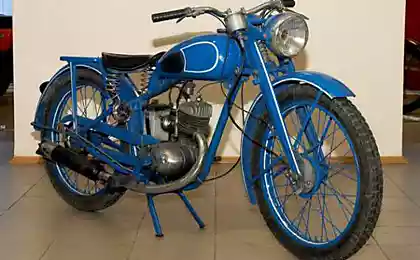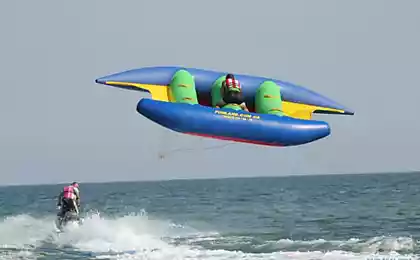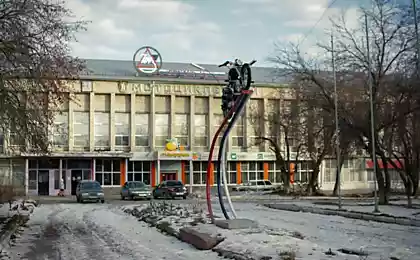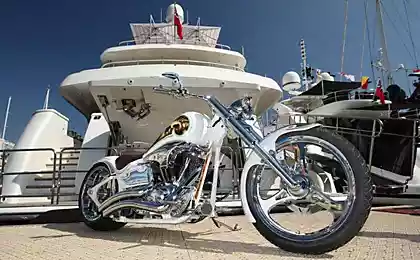4879
Museum of vintage motorcycles in Irkutsk
For 5 years he collected a good collection, and decided to give it to the city, opening the Museum: now put 25 pieces of equipment, soon it will be 40. Also Vladimir plans to complete your collection of foreign exhibits and collect the whole line of the Soviet two-wheeled machinery. All equipment is on the move: sit down and drive. In the museum also exhibits taken from those who want :) On the View motorcycles can watch, smell, touch and sit down, madly happy.

At the entrance we were met by a bright and cheerful ant inviting to come.
It all started with a bike:

Mopeds Riga-16. Produced in the USSR in 1977 and at a body weight of 45 kg were capable of carrying loads up to 115 kg. Moped motorcycle was fitted with a silencer type, Kick, rear brake lever, rear lamp:

Moped Verhovina production Lviv Motoplant with improved engine SH-58

Mokik Carpathians also made by LMZ with V-50 engine and manual gearbox:
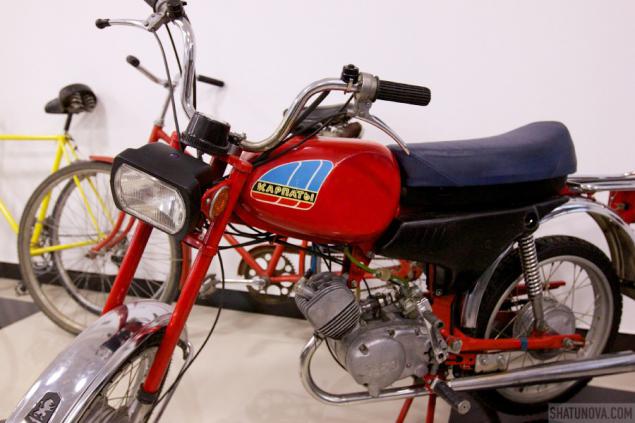
By the way, did not know what Lviv Motoplant put on wings logo "Peugeot". As far as I know, the other factory logo.
Multi-colored scooters I always evoke a sense of joy of children: bright, cartoon-like colored candy Monpase who want to eat). When restoration motoroshki were specially painted in different bright colors to immediately catch the eye:
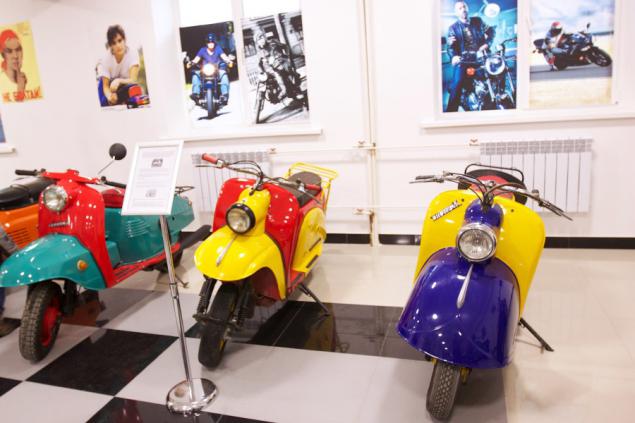
Scooters Tulitsa:
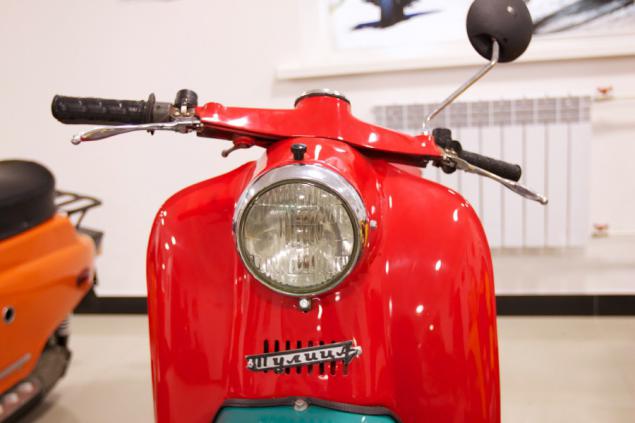



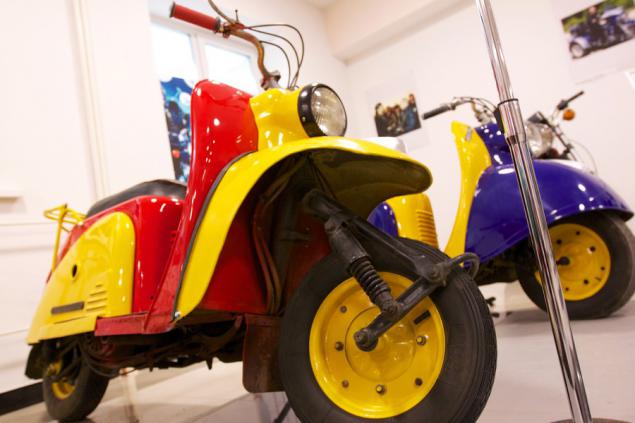
Three-color Model T-200M:
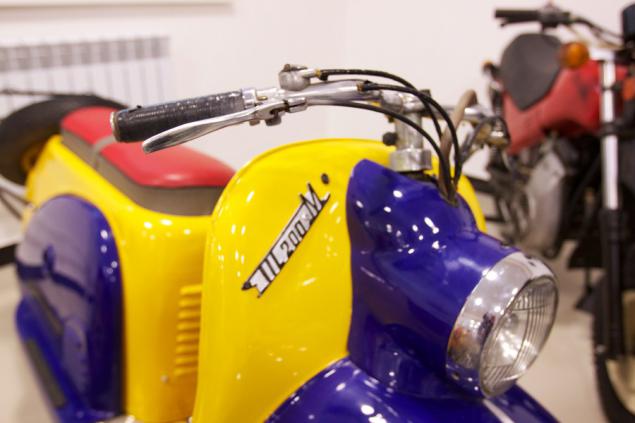


Orange motoroshka Vyatka B-150M, a descendant of the adjacent burgundy VP-150. Updating the model, Soviet designers scored on appearance, but improved specifications for driving on rural Soviet potholes, except that the size of the wheels left the same:

Key in the ignition if requested to have a motor:


Standing next to burgundy Vyatka VP-150 - the first Soviet motor scooter that is an exact copy of the Vespa 150GS 1955 (except for some details, such as the label on the wing, 3 assists and a round speedometer). The museum is represented by an instance of the 1960s. Gorgeous Wing:
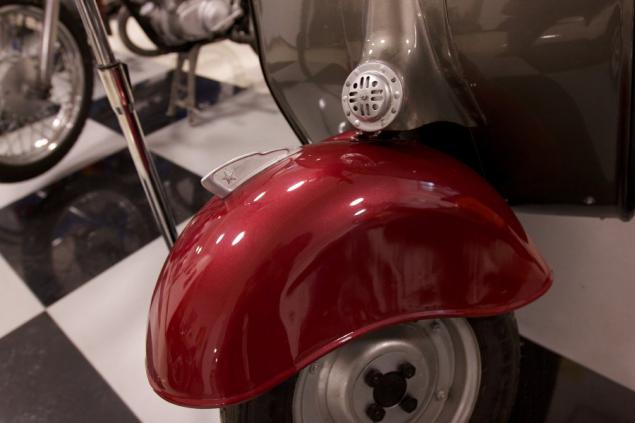
Beautiful oval trunks give the image of perfection. Italian design catches the eye:

Ural kolyasych:


M-72 - a motorcycle, manufactured exclusively for military purposes from 1941 to 1960. Up to 1950. the free market did not and was classified as armored vehicles, as are carriers of small arms. Motorcycle produced at the Moscow plant, Kiev, "Red October", Irbit, Gorky. In all there were more than 8,500 units. This copy 1956 issue:


Yavochka old woman with stylish stroller Pannonia Dong:



Java "foam" 350 with sidecar:

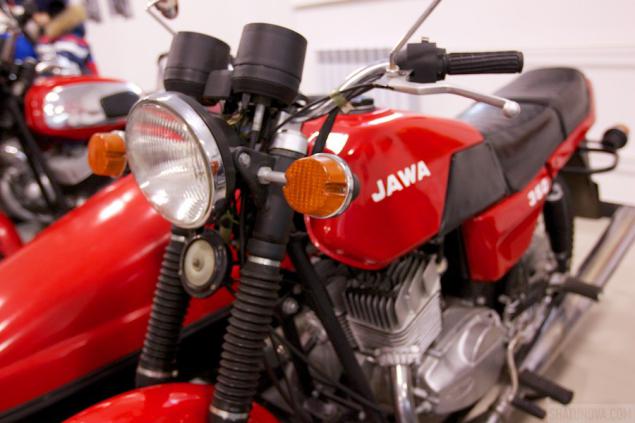
Sinenky Jupiter IL-3, produced from 1971 on this model have been delivered turn signals (in previous versions they were not), and increased the amount of hp to 25, with which the motorcycle could reach speeds of up to 120 km / h.
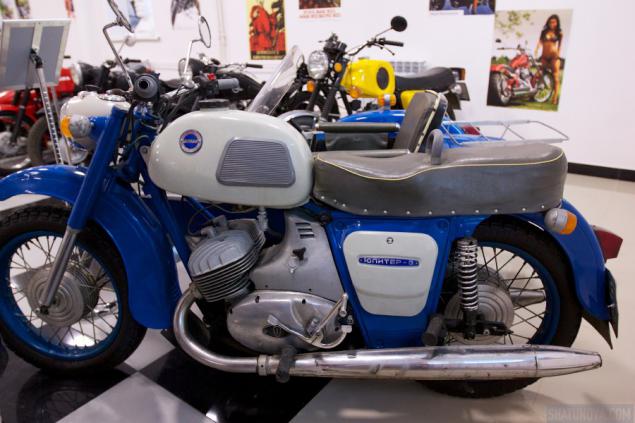


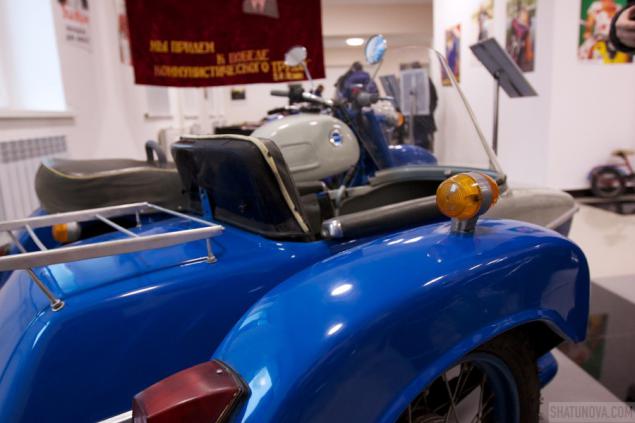
The museum has even introduced a police Urals:

And it is a hybrid: the Urals to the engine from the Cossacks. Perhaps there were also used parts from other bikes, not exactly say:


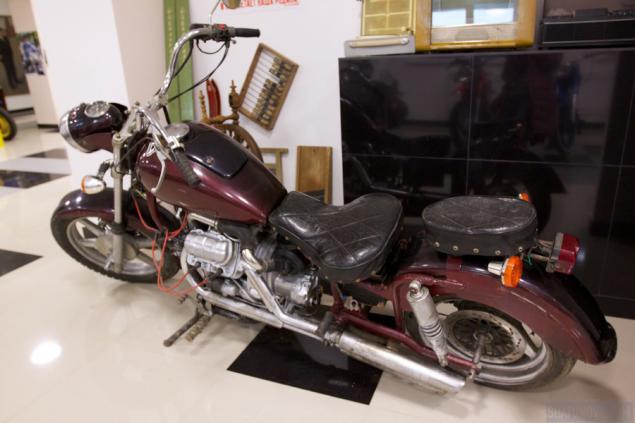



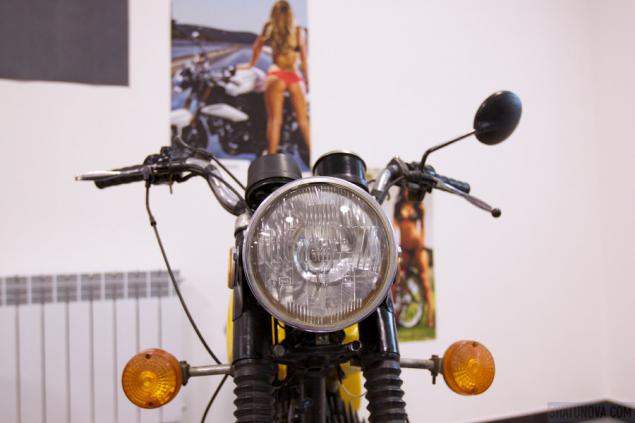
Near the entrance is a Chezet a sporty design:

By the way, the entourage of the museum includes many Soviet related things like old skis, cameras, samovars, etc. Full set for those wishing ponastalgirovat.I music playing old plastinochnyh:

The most fashionable motorcycle in the USSR:
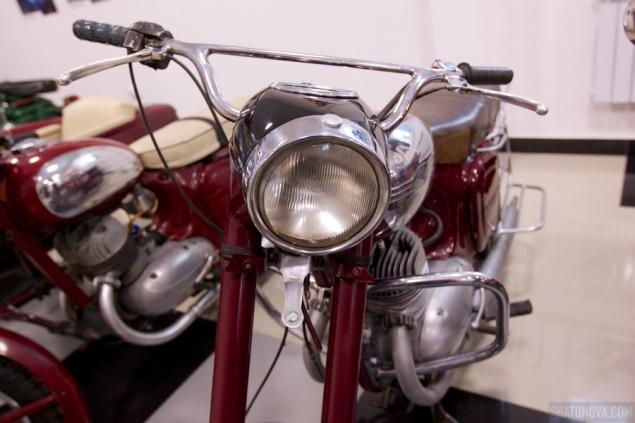
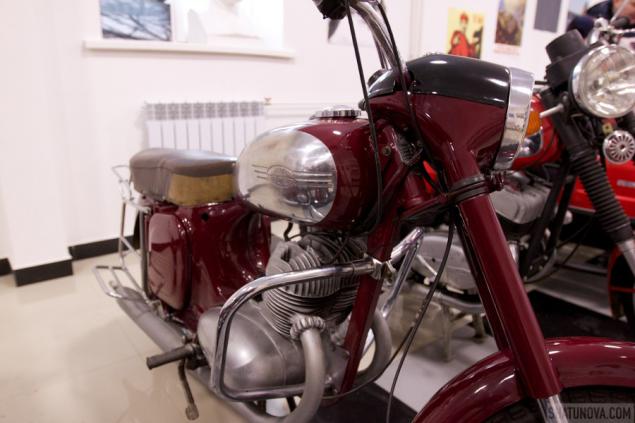

This Java already present: the model 634 1973 of release:



IZH-56, manufactured from 1956 to 1962. Here is a model with separate seats, also produced a model with dual seat. And why did the Japanese do not put the handles on the saddle, as convenient as: ILO convenient and roll, and the central place bandwagon. Only passengers uncomfortable :) This model replaced the stamped frame tubular lever to change gears manually removed from the tank to the engine carburetor is completely enclosed, sealed enclosure protection circuit. Kick as well as throughout the Soviet motorcycle was located on the left, as part of the IZH-56 issued with a sidecar.


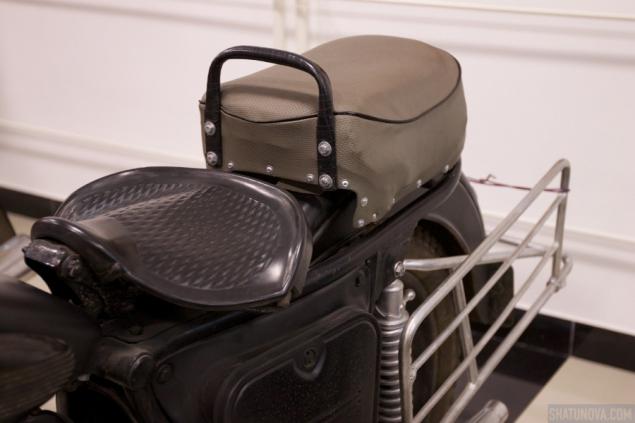
Next to him is his predecessor IZH-49 with manual transmissions, located on the tank. This model was produced from 1951 to 1958. Fork telescopic hydraulic shock absorbers and some other improvements have increased driving comfort and permeability:




Little yellow Bumblebee - it Izh Planeta Sport. Model was produced from 1973 to 1984. Due to high quality technical performance, this model was in demand even abroad: in Finland, Great Britain, Holland. In this model, the first time in the Soviet Union used the separate engine lubrication system of its own design (IL-MAMI). After 1980, most of the motorcycles produced are exported. The engine was equipped with a carburetor Mikuni Japanese, allowing the bike to accelerate to 100 km / h for 11 seconds. It was promoted and lightweight motorcycle: 135 kg dry. The engine was mounted in a frame with rubber cushions - it was a novelty. And in the early years of the release of the Japanese model was equipped with electricians and German optics company Hella.



Motorcycle series issued by the Minsk motorcycle, bicycle factory (MMVZ). By year and model in detail is not to say, can someone tell me from the experts:


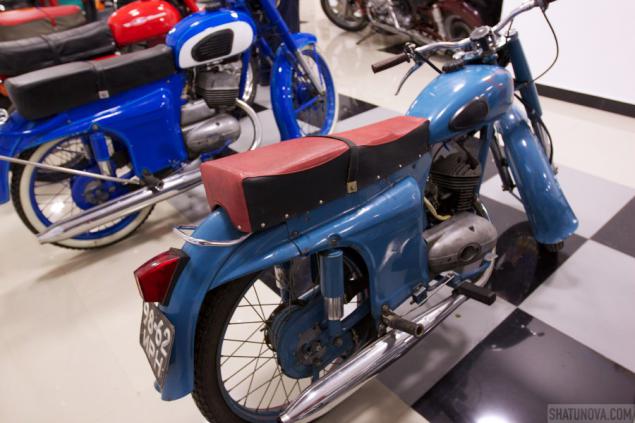







Kovrovets - road motorcycles production plant im.Degtyareva (ZiD). Similar models were produced on MMVZ. The museum presents a model of K-175, produced from 1957 to 1965. The model was a two-stroke single-cylinder engine, carburetor cover is closed, the 16-inch wheels, fully enclosed chain and sidushka form "loaf". On some bikes K-175 was mounted semi-automatic cutoffs of coupling.

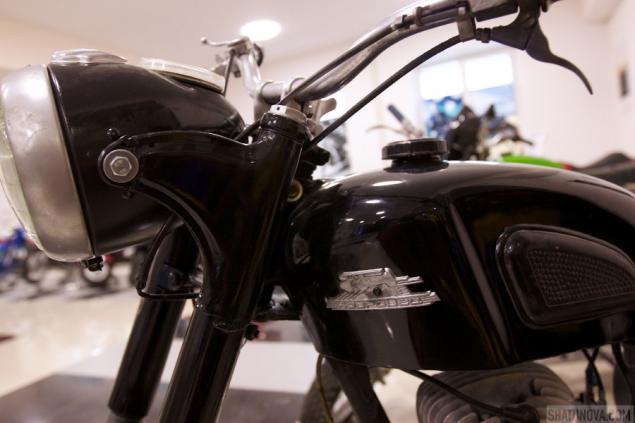
Sunrise 3M-01, produced at the plant them. Degtyareva since 1989. This model is a descendant of the motorcycle Kovrovets K-175. This sets a new motorcycle engine with a lamellar flap, increased piston skirt, wider wheel with a jumper. Fuel consumption was reduced to 4 2 liters / 100 km. and increased power up to 15 hp at 6000 rpm. / min .:


Motorcycle-tractor Tula TMZ-5.951-952. This is the first Soviet offroad motorcycle made from 1984 to 1996. And it was first applied electric starter and air cooling.


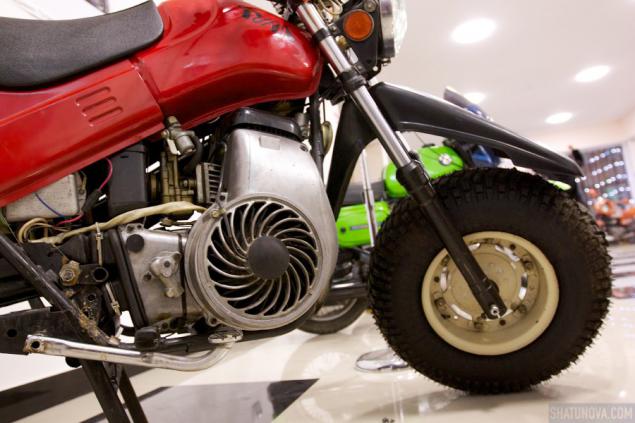
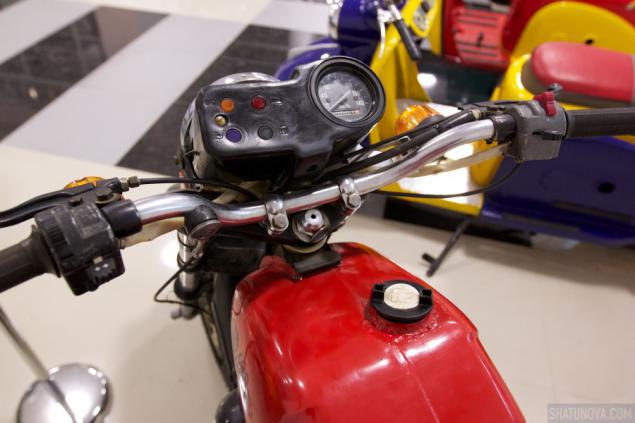
Minsk Motorcycle M-1A 1953 beautiful blue with sparkles and white tires. Photos not quite conveys the beauty of coloring horse. Live color looks interesting. Motorcycle - a cart in fact, as you can see, it does not have rear shock absorbers. This is one of the most valuable specimens of the museum. This model - the first, which was released on MMVZ.



Another Minsk:

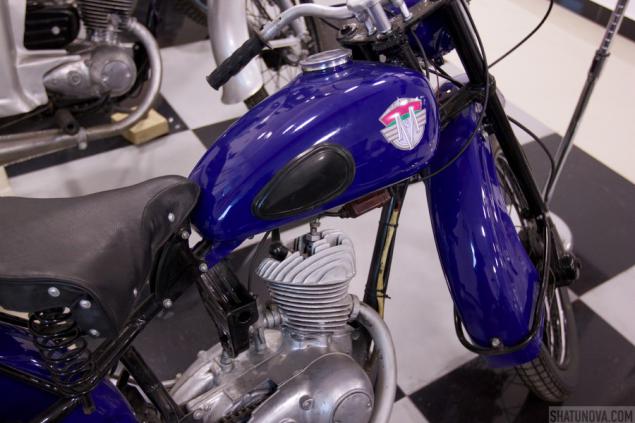



At the entrance we were met by a bright and cheerful ant inviting to come.
It all started with a bike:

Mopeds Riga-16. Produced in the USSR in 1977 and at a body weight of 45 kg were capable of carrying loads up to 115 kg. Moped motorcycle was fitted with a silencer type, Kick, rear brake lever, rear lamp:

Moped Verhovina production Lviv Motoplant with improved engine SH-58

Mokik Carpathians also made by LMZ with V-50 engine and manual gearbox:

By the way, did not know what Lviv Motoplant put on wings logo "Peugeot". As far as I know, the other factory logo.
Multi-colored scooters I always evoke a sense of joy of children: bright, cartoon-like colored candy Monpase who want to eat). When restoration motoroshki were specially painted in different bright colors to immediately catch the eye:

Scooters Tulitsa:





Three-color Model T-200M:



Orange motoroshka Vyatka B-150M, a descendant of the adjacent burgundy VP-150. Updating the model, Soviet designers scored on appearance, but improved specifications for driving on rural Soviet potholes, except that the size of the wheels left the same:

Key in the ignition if requested to have a motor:


Standing next to burgundy Vyatka VP-150 - the first Soviet motor scooter that is an exact copy of the Vespa 150GS 1955 (except for some details, such as the label on the wing, 3 assists and a round speedometer). The museum is represented by an instance of the 1960s. Gorgeous Wing:

Beautiful oval trunks give the image of perfection. Italian design catches the eye:

Ural kolyasych:


M-72 - a motorcycle, manufactured exclusively for military purposes from 1941 to 1960. Up to 1950. the free market did not and was classified as armored vehicles, as are carriers of small arms. Motorcycle produced at the Moscow plant, Kiev, "Red October", Irbit, Gorky. In all there were more than 8,500 units. This copy 1956 issue:


Yavochka old woman with stylish stroller Pannonia Dong:



Java "foam" 350 with sidecar:


Sinenky Jupiter IL-3, produced from 1971 on this model have been delivered turn signals (in previous versions they were not), and increased the amount of hp to 25, with which the motorcycle could reach speeds of up to 120 km / h.




The museum has even introduced a police Urals:

And it is a hybrid: the Urals to the engine from the Cossacks. Perhaps there were also used parts from other bikes, not exactly say:







Near the entrance is a Chezet a sporty design:

By the way, the entourage of the museum includes many Soviet related things like old skis, cameras, samovars, etc. Full set for those wishing ponastalgirovat.I music playing old plastinochnyh:

The most fashionable motorcycle in the USSR:



This Java already present: the model 634 1973 of release:



IZH-56, manufactured from 1956 to 1962. Here is a model with separate seats, also produced a model with dual seat. And why did the Japanese do not put the handles on the saddle, as convenient as: ILO convenient and roll, and the central place bandwagon. Only passengers uncomfortable :) This model replaced the stamped frame tubular lever to change gears manually removed from the tank to the engine carburetor is completely enclosed, sealed enclosure protection circuit. Kick as well as throughout the Soviet motorcycle was located on the left, as part of the IZH-56 issued with a sidecar.



Next to him is his predecessor IZH-49 with manual transmissions, located on the tank. This model was produced from 1951 to 1958. Fork telescopic hydraulic shock absorbers and some other improvements have increased driving comfort and permeability:




Little yellow Bumblebee - it Izh Planeta Sport. Model was produced from 1973 to 1984. Due to high quality technical performance, this model was in demand even abroad: in Finland, Great Britain, Holland. In this model, the first time in the Soviet Union used the separate engine lubrication system of its own design (IL-MAMI). After 1980, most of the motorcycles produced are exported. The engine was equipped with a carburetor Mikuni Japanese, allowing the bike to accelerate to 100 km / h for 11 seconds. It was promoted and lightweight motorcycle: 135 kg dry. The engine was mounted in a frame with rubber cushions - it was a novelty. And in the early years of the release of the Japanese model was equipped with electricians and German optics company Hella.



Motorcycle series issued by the Minsk motorcycle, bicycle factory (MMVZ). By year and model in detail is not to say, can someone tell me from the experts:










Kovrovets - road motorcycles production plant im.Degtyareva (ZiD). Similar models were produced on MMVZ. The museum presents a model of K-175, produced from 1957 to 1965. The model was a two-stroke single-cylinder engine, carburetor cover is closed, the 16-inch wheels, fully enclosed chain and sidushka form "loaf". On some bikes K-175 was mounted semi-automatic cutoffs of coupling.


Sunrise 3M-01, produced at the plant them. Degtyareva since 1989. This model is a descendant of the motorcycle Kovrovets K-175. This sets a new motorcycle engine with a lamellar flap, increased piston skirt, wider wheel with a jumper. Fuel consumption was reduced to 4 2 liters / 100 km. and increased power up to 15 hp at 6000 rpm. / min .:


Motorcycle-tractor Tula TMZ-5.951-952. This is the first Soviet offroad motorcycle made from 1984 to 1996. And it was first applied electric starter and air cooling.




Minsk Motorcycle M-1A 1953 beautiful blue with sparkles and white tires. Photos not quite conveys the beauty of coloring horse. Live color looks interesting. Motorcycle - a cart in fact, as you can see, it does not have rear shock absorbers. This is one of the most valuable specimens of the museum. This model - the first, which was released on MMVZ.



Another Minsk:




